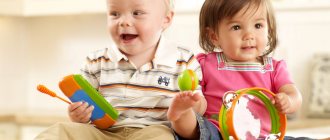Preschool age
During this period, role-playing play is of greatest importance for the child. By recreating a certain plot, he tries to experience for himself what it’s like to be adults. And if at an early age toys become the main subject of play, now they are turning from an object into a means at hand. Such activities help the child establish contact with parents and other people around him, influence him, and also develop his personality in different directions. Through the game he learns:
- agree;
- think in the mind;
- fantasize;
- establish connections with other children;
- express your desires and feelings.
The older the child, the more noticeable is the transformation of his play from an object-cognitive form to a plot-role form. It is during this period that play is the leading activity that has the greatest impact on the baby and his personal development.
After seven or eight years, children acquire the ability to learn. Therefore, at this age, play ceases to be a leading activity for them. Education comes to the fore, they are protected from their parents and begin to independently choose their environment
In the future, these processes gain even greater expression, but it is important for parents to know that caution and prudence in their offspring appears only by the age of 15, and therefore their role as protectors and guardians will still be relevant in the next few years
Periodization of leading activities in child development
Periodization and delimitation of leading activities occurs on the basis of age periodization and changes in psychological ages. Each such transformation occurs through the passage of a crisis transformation, where a person can get stuck or go through it quickly. The methods of coping also differ; for some, the change in activity occurs softly and organically, while for others it resembles a local apocalypse. There are different types of turning points: relationship crises (three and twelve years), resulting from changes in social position and interaction, and crises of ideological concepts (one, seven and fifteen years), confronting the individual with a change in his semantic space.
Periods characterized by a certain type of leading activity are divided into:
- Infancy (2 months - 1 year): the leading type of activity is carried out unconsciously, obeying primary instincts, manifests itself in emotional communication with the environment.
— Early age (1 - 3 years) is distinguished by the predominance of object-tool (manipulative) activity that takes on a social context, i.e. implies precisely a social way of mastering a subject. There is a lot of experimentation with the qualities of objects.
- Preschool age (3 - 7 years) - the main activity of the development of mental neoplasms comes down to the study and interiorization of social role-based interpersonal interactions. It is carried out through role-playing games to understand the relationships, tasks, motives of various actions depending on the accepted social role and the object used. Here, norms and rules, peculiarities of culture and society, and the development of the ability to communicate with peers are learned. The formation of this social layer so early makes it difficult to change these parameters in the future.
- Junior school age (7 - 11 years) - the leading activity is educational activity, and any activity that allows one to acquire new knowledge is considered.
- Adolescence (11 - 15 years) - there is a shift in priorities towards intimate and person-oriented communication, and if at the previous stage communication played a functional role for learning, now learning becomes a platform for communication.
— Youth (graduation from school) is characterized by educational and professional activity, where new goals and value systems are established and necessary skills are honed.
The activity of any stage is multifaceted and has a motivational and operational side. One of these components may predominate, since their development is not synchronized, and their tempo characteristics are due precisely to the activity being performed. It is noticed that there is an alternation of activities with a predominance of either a motivational or an operational component. For example, if in infancy the motivational side and the emotional aspect of interaction are maximally involved, then at the next stage operational interaction with the world and its study begins to predominate. Then further change and alternation occurs again. Such alternations are always oriented towards advance, creating with such a gap the conditions for further development. A high level of motivation leads the child to those conditions where he begins to feel a lack of operational skills, and then the next type of activity is turned on. At the stage of complete mastery of the operational aspects of a certain period, a lack of motivation begins to be felt, which does not allow one to remain at the achieved level and, accordingly, a new phase of development begins, with a predominant motivational component. The conflict between motivation for achievement and the level of opportunities present is an internal element of triggering development.
It is important to understand that such a confrontation between the leading components does not mean the presence of only one of them; rather, their influence is inseparable; the focus of attention simply changes from the operational side to the motivational side and back
Definition of age
The concept of age includes a number of aspects:
- Chronological age – determined by a person’s life expectancy (according to the passport);
- Biological age is a set of biological indicators, the functioning of the body as a whole (circulatory, respiratory, digestive systems, etc.);
- Psychological age is a certain level of mental development, a category that serves to designate the temporary characteristics of individual development. In contrast to chronological age, which expresses the duration of an individual’s existence from the moment of his birth, the concept of psychological age denotes a certain, qualitatively unique stage of ontogenetic development, determined by the laws of the formation of the organism, living conditions, training and upbringing and having a specific historical origin.
Leading activities in adolescence
Educational activity in adolescence changes its focus and becomes more professional, having its orientation towards the future, and not the futile assimilation of absolutely all knowledge. It is at this age that a change in attitude towards subjects occurs; those that are directly related to the chosen future profession begin to be more actively studied. It is possible to attend additional courses, transfer to educational institutions specializing in the chosen activity (specialized lyceums, colleges, technical schools).
The appearance of this specification does not yet indicate self-determination, but indicates readiness for it, i.e. a number of areas are selected where a person is ready to try himself or a general direction of development, which will be specified by further elections (institute, department, scientific work, specialization). But the formation of high levels of theoretical thinking, social worldview, abilities for self-awareness, self-development, and reflection allows one to take the first steps towards self-determination.
Professional self-determination cannot be defined as an instantly made decision. This is a process extended over time, which began several years before adolescence and will end several years after. But if at the previous stages there is an acquaintance with many areas of activity, which allows one to make a choice of industry, and in the future there is a narrow specialization in the chosen direction, then it is the teenage period that is the transitional moment and the time for making a choice.
The older a person gets, the stronger the pressure on him to make a choice, and all unrealistic ideas recede. Thus, the majority of those who want to become astronauts and models evaluate their inclinations, skills and capabilities and make a choice based on real prerequisites, and not on an image taken from a magazine. In addition to external factors that stimulate rapid self-determination, this is facilitated by internal processes of the individual, which boil down to the motivational need to take the position of an adult in society. The need for self-realization comes to the fore and becomes more relevant than ever. All the accumulated experience and the resulting personal development at this stage already takes place in the application of forces and can be aimed at realizing dreams and gaining independence.
Acceptance of responsibility and the willingness to be responsible for one's own life, make choices and contribute to the development of society matures in the adolescent period of development. The further life path of the individual and possible successes depend on how conscious professional self-justification is. In many ways, the problem of professional choice becomes a problem of life path and space, realization of not only professional, but also personal. Such a burden of responsibility and seriousness of the decision made forces the individual to face another developmental crisis, which affects almost all manifestations and can have a long and pathological course. Failures and negative consequences are especially likely if the tasks of the previous stages have not been fully mastered.
There is also a further periodization of ages and mental characteristics, which is also accompanied by personality crises. In this case, time intervals become longer, which is due to the lack of need to understand the world, as well as a slowdown in physiological and psychological processes.
Early childhood - 1-3 years
After a year, children begin to take an active interest in the world around them. In order to become “like” adults, they imitate them in everything, trying to use various substitutes as tools. So, a stick replaces a spoon, a sand bucket replaces a cup, they treat toys with dad’s headphones, and they fix a car with their own finger, imagining it as a screwdriver. In this way, children develop imaginative thinking, they study the various properties of objects. Over time, the game evolves and becomes more intelligent, versatile, several characters appear in it, each of which has its own role.
Literature
- Burmenskaya G.V. Developmental psychological approach to counseling children and adolescents - Proc. aid for students higher textbook institutions M.: Publishing house, 2002. - 416 p.
- Karabanova O. A. Age psychology. Lecture notes M.: Iris-press, 2005. - 238 p.
- Obukhova L. F. Child psychology: theories, facts, problems. — 3rd edition, stereotypical. - M.: Trivola, 1998. - 352 p.
- Terekhina N.V. Leading activities of adolescence from the point of view of the main developmental tasks - Moscow City Psychological and Pedagogical University, 2010
- Elkonin B.D. Introduction to developmental psychology (in the tradition of the cultural-historical theory of L.S. Vygotsky) M.: Trivola, 1994 - 168 p.
- Elkonin D. B. Child psychology: textbook. aid for students higher textbook establishments. — 4th ed., erased. - M.: Publishing House, 2007. - 384 p.
Periodization of age development
Issues of periodization of age-related development have interested scientists involved in various human sciences throughout the history of mankind.
Periodization of age development according to Pythagoras :
- Spring (up to 20 years);
- Summer (20-40 years);
- Autumn (40-60 years);
- Winter (after 60 years).
Periodization of age development according to Roslavsky and Petrovsky :
- Younger generation (up to 15 years):
- Minors (under 5 years old);
- Children (from 5 to 15 years old).
- Blooming generation (from 16 to 60 years):
- Young (from 16 to 30 years old);
- Mature (from 30 to 45 years old);
- Elderly (from 45 to 60 years old).
- Fading generation (from 60 years):
- Old (from 60 to 75 years);
- Long-lasting (from 75 years).
Currently, Markosyan’s , adopted at the International Symposium on Age Periodization in Moscow in 1965, is considered generally accepted and generally scientific:
| № | Name | Boys/men | Girls/women | |
| 1 | Newborns | 1-10 days | ||
| 2 | Infancy | 10 days – 1 year | ||
| 3 | Early childhood | 1-3 years | ||
| 4 | First childhood | 4-7 years | ||
| 5 | Second childhood | 8-12 years | 8-11 years | |
| 6 | Adolescence | 13-16 years old | 12-15 years | |
| 7 | Adolescence | 17-21 years old | 16-20 years old | |
| 8 | Mature age | First period | 22-35 years old | 21-35 years old |
| Second period | 36-60 years | 36-55 years old | ||
| 9 | Elderly age | 61-74 years | 56-74 years | |
| 10 | Senile age | 75-90 years | ||
| 11 | Centenarians | From 90 years old | ||
The most common in Russian psychology is the age-based periodization of psychological development based on leading activity, proposed by D.B. Elkonin.
Leading activities in primary school age
Entering this age is characterized by a change in lifestyle and the development of a fundamentally new activity - educational. A child’s presence at school lays down new theoretical knowledge and forms social status, develops interaction with people, which determines the child’s own place in this hierarchy of interaction. In addition to dramatic changes in conditions and lifestyle, difficulties for the child lie in physiological changes and weakening of the nervous system. In a growing organism, developmental disharmony occurs when rapid physical growth predominates at this stage and most of the body’s resources are spent on this. Problems of the nervous system can manifest as increased excitability, motor activity, anxiety and fatigue. There is an increase in vocabulary, it is possible to invent your own language.
In learning, not only the theoretical knowledge and experience of previous generations is absorbed, but also systems of control, evaluation and discipline. Through educational activities, interaction with society occurs, the child’s basic personal qualities, semantic guidelines, and value preferences are formed.
The acquired knowledge now represents theoretical experience accumulated over generations, rather than direct substantive study of the subject. A child cannot change the use of an object, the course of biological reactions, history, physical processes, but when interacting with knowledge about this, he changes himself. No other activity, except educational activity, puts the person himself as the object of change. This is how the development of internal qualities and processes occurs. At this stage, the cognitive task is still determined by the teacher, and attention is directed. At the next stages, the child learns to independently search for meaning and identify needs.
Educational activity manifests itself as self-changes and the ability to notice these changes. Here reflection begins to develop, an objective assessment of one’s skills and needs, and the correspondence of existing knowledge to the task at hand. The ability to regulate one’s behavior in relation to social norms, and not just one’s own needs, is formed.
Learning occurs in building interpersonal relationships with representatives of various categories. Thus, interactions and friendships with peers are formed not by personal qualities of interest, but by external circumstances. A school friend becomes the one who sits on the next desk or stands nearby during physical education. In addition to equal communication, a style of interaction with adults is formed, which at the moment is also impersonal. The child learns to obey the hierarchy, and the relationship with the teacher is assessed through the prism of academic performance.
From birth to one year
During the first year of life, a person is very dependent on other people. By and large, he will not survive without his parents or other adults caring for him. Child development specialists believe that it is incorrect to use the very concept of “leading activity” for children under two months of age. This is wrong, because such crumbs, in principle, are not able to express themselves in any way. But having overcome this milestone, they begin the first stage of their development, in which they must establish emotional and communicative connections with loved ones
At this time, a person learns to differentiate his feelings, concentrate attention, adequately perceive the environment, he develops the rudiments of speech skills and logical thinking, with an awareness of cause-and-effect relationships
Why do parents need knowledge about leading activities?
Knowledge and understanding by parents of the laws of age-related development of children leads to a simplified understanding and acceptance of the fact that the concepts of leading activity and leading type of communication play a special role, since they determine the development of cognitive processes in the child and form the main personality traits.
And although the leading types of communication and activities change as the child’s age changes, their diversity increases.
In addition, it should be taken into account that play is a key activity at almost every stage and can be seen and used as a mediator to promote children's cognitive development and relationship building.
Leading activities at an early age
At an early age, after the motivational component has been saturated with emotional communication, the child’s leading activity is distinguished as object-manipulative. The main task is to learn how to interact with objects of interest, which can happen when repeating the actions of an adult, as well as when inventing new, sometimes original and impractical ways of using them. You may try to collect sand into the bucket not with a spatula, but with a strainer, or comb it with lipstick, etc. Development occurs best if the child masters as many actions as possible that interest him (usually through repeated repetition), and also invents a large number of ways to use the object.
The more simple actions the child practices by repeating after his parents, the more detailed he explores the subject, the better his personal understanding will be formed. The number of subjects should increase after one has been studied completely, i.e. The principle of intensive and deep study of one subject, instead of superficial acquaintance with many things, operates here. Often this comes down to repeating an action a huge number of times, without any final meaning (rolling the machine, wiping all surfaces with a cloth, regardless of dirt, etc.). From the point of view of adults, these repetitions may be meaningless, but they stimulate the child’s thinking and search for new solutions.
Interaction in various ways, rather than theoretical acquaintance with the subject, allows the child to remember it well, form his own idea about it, be able to pronounce its name and many other basic things. If a child is simply shown a new object, called its name and shown how to handle it, then there is no question of remembering the name at all, and the manipulations will be of an educational nature.
Manipulative activity finds its implementation in household chores. By allowing the baby to help in activities such as mopping the floors, watering flowers, cooking dinner, cutting out cookies, etc., parents simultaneously introduce him to all household objects and allow him to learn how to interact with them in an interesting way
In addition, involvement in home activities, as a habitual way of life, will help mitigate the crisis of the third birthday, when the question of one’s place in the world and social importance becomes acute.
The use of special games also helps to develop these functions, but their use should be an auxiliary tool. The development of a child in special, artificial conditions immerses him in a fictional world, and learning to interact with reality does not occur. Such children can be excellent at moving chips, but find themselves absolutely helpless when tying their shoelaces. So, by leaving household chores to the active phase of the child’s day and involving him in the process, parents provide him with more care than by trying to do all the cleaning during the child’s sleep.
An important rule is to accept mistakes and allow your child to make them and learn from them. Let the plate fall while washing the dishes because it is soapy and slippery, let it be the sixth broken plate, but on the seventh he will understand and everything will work out. If parents do not understand the ongoing process, then one may encounter impatience and the child’s withdrawal from the chosen activity. This stops the formation of the skill, the need for development is frustrated, the child’s self-esteem decreases and motivation disappears.
MAGAZINE Preschooler.RF
Abstract Currently, the attention of many psychologists around the world is drawn to the problems of child development. This interest is far from accidental, since it is discovered that the preschool period of life is the period of the most intensive and moral development, when the foundation of physical, mental and moral health is laid. The future of the child largely depends on the conditions under which it occurs. At the same time, multiple factors influencing the socialization of the individual are also laid down and formed precisely in the preschool period of the child’s development. Preschool age is a particularly important period in education, since it is the age of initial formation of the child’s personality. After all, it is preschoolers who begin to develop the main psychological characteristics: motive for achievement, intelligence, abilities, etc. At primary school age, they are consolidated and become stable or develop further. The works of outstanding domestic and foreign scientists are devoted to the preschool period: S.L. Rubenshnein, L.S. Vygotsky, A.N. Leontiev, A.V. Zaporozhets, V.V. Davydov, C. Rogers, J. Piaget. But still, the study of this transition remains one of the most pressing problems of modern developmental psychology, and this problem is directly related to the problem of the child’s motivational readiness for schooling. Therefore, the topic of my work is very important and relevant. Preschool age is the stage of mental development from 5 to 7 years. Very important for the formation of a child’s personality. Within its framework, three periods are distinguished: - junior preschool age - from 3 to 4 years; -middle preschool age - from 4 to 5 years; - senior preschool age - from 5 to 7 years. Purpose: to study the period of preschool childhood and its psychological characteristics. Objectives: define the concept and study the main features of the mental development of a child in preschool age; structure and dynamics of leading activities in preschool age; the main neoplasms of this period; consider psychological readiness for learning as a result of the psychological development of a preschooler. Key words: game, preschool age, personality formation, childhood. The leading type of activity in preschool age The future of the child largely depends on the conditions in which childhood takes place. In the game, all mental processes intensively develop, the first moral feelings are formed (what is bad and what is good). The separation of gaming and real conditions occurs gradually in a child at school. The child's attention is focused on what he is doing. Having noticed an object or person that attracts his attention, a child can rush towards it, forgetting about everything in the world. This is why play is important for children. The leading activity during this period is play. The nature of the game changes along with the child’s development; it also goes through stages. The main thing that the child gets in the game is the opportunity to take on a role. In the course of playing this role, the child’s actions and his attitude to reality are transformed. Up to three years of age, the game involves manipulating objects. The baby, if he is healthy, plays all the time he has free from sleeping and eating. With the help of toys, he gets acquainted with color, shape, sound, etc., that is, he explores reality. Later he begins to experiment on his own: throwing, squeezing toys and observing the reaction. During the game, the child develops coordination of movements. Play itself begins at the age of 3, when the child begins to think in holistic images - symbols of real objects, phenomena and actions. Thus, the main thing that the child receives in the game is the opportunity to take on a role. In the course of playing this role, the child’s actions and his attitude to reality are transformed. Play is the leading activity of a preschool child. The subject of gaming activity is an adult as a bearer of certain social functions, entering into certain relationships with other people, using certain rules in his activities. The main change in behavior is that the child’s desires fade into the background, and strict adherence to the rules of the game comes to the fore. Each game has its own playing conditions - the children, dolls, and other toys and objects participating in it. At first, the child is limited to the family and therefore his games are connected mainly with family and everyday problems. Then, as he masters new areas of life, he begins to use more complex plots - industrial, military, etc. In addition, the game with the same plot gradually becomes more stable and longer. If at 3-4 years old a child can devote only 10-15 minutes to it, and then he needs to switch to something else, then at 4-5 years old one game can already last 40-50 minutes. Older preschoolers are able to play the same thing for several hours in a row, and some games last for several days. Younger preschoolers imitate object-based activities - cutting bread, grating carrots, washing dishes. They are absorbed in the process of performing actions and sometimes forget about the result - why and for whom they did it. For middle preschoolers, the main thing is the relationships between people; they perform play actions not for the sake of the actions themselves, but for the sake of the relationships behind them. Therefore, a 5-year-old child will never forget to place the “sliced” bread in front of the dolls and will never confuse the sequence of actions - first lunch, then washing the dishes, and not vice versa. For older preschoolers, it is important to obey the rules arising from the role, and the correctness of their implementation of these rules is strictly controlled. Game actions gradually lose their original meaning. Actual objective actions are reduced and generalized, and sometimes completely replaced by speech (“Well, I washed their hands. Let’s sit down at the table!”). There are 2 main phases or stages in the development of the game. The first stage (3-5 years) is characterized by the reproduction of the logic of people’s real actions; The content of the game is objective actions. At the second stage (5-7 years), real relationships between people are modeled, and the content of the game becomes social relationships, the social meaning of an adult’s activity. The role of play in the development of a child’s psyche. 1) In the game, the child learns to fully communicate with peers. 2) Learn to subordinate your impulsive desires to the rules of the game. A subordination of motives appears - “I want” begins to obey “I can’t” or “I must.” 3) In the game, all mental processes intensively develop, the first moral feelings are formed (what is bad and what is good). 4) New motives and needs are formed (competitive, gaming motives, the need for independence). 5) New types of productive activities arise in the game (drawing, modeling, appliqué). A game action is not born from an imaginary situation, but on the contrary, an operation with an action causes a game situation. Thus, the conditions of the game action promote imagination and make it necessary. While the child is not playing, he does not imagine a game situation, and fantasy does not work. Only during the game does the object seem to disintegrate into material properties and game meaning. A child’s play activity is always generalized because the motive is not a reflection of a specific phenomenon, but the action itself, as a personal relationship. In play, a child does not inherit or transmit special, characteristic behavior; he always typifies. Intuition stimulates fantasy, and fantasies stimulate the development of creative thinking. Every active person has an ineradicable need to move from sensory knowledge of the world to rational knowledge, where thinking, the mechanism of which is mediocrity. Thinking is the process of indirect cognition of things and phenomena, understanding the connections and relationships between them. In all sensory phenomena, the child strives to the best of his ability to find the appropriate meaning, and it does not end with “how?” Why? For what?" aimed at discovering the secrets of their existence. The new things that appear to a child every day are a mystery to him. Thinking becomes a generalization as a result of observations, a generalization of oriented activity. A person does not calm down until a mysterious, unknown phenomenon, which excites by its very existence, is given a certain meaning, which first occurs in the game. Children love it when adults (parents, relatives) play with them. This refers primarily to very active noisy games and fun romp. Rocking on bent legs, lifting, throwing, imaginary wrestling on the sofa (with giveaways) bring the child a lot of joy, cheerful excitement and physical fitness. Playing for a child is a very serious activity. Adults should see in the child’s play elements of preparation for future work processes and guide them accordingly by taking part in it. It is necessary to take care of toys so that the child can organize play. For children, first of all, we need dolls depicting adults of different professions, or characters from famous fairy tales. To play with a doll, you need furniture and dishes of a suitable size. Soft toys depicting animals. Cars and various transport. Mechanical wind-up toys develop interest in technology. A variety of building kits and constructors are very useful. They open up space for children's imagination. For children of senior preschool age, sets of a large number of parts that are connected to each other in various ways are suitable. Using such a set gives the child the skill of screwing nuts and using a wrench. The most interesting toys for children are homemade ones. They are especially valuable when the children themselves, together with an adult, under his command, are involved in the process of making homemade toys. This develops their independence and fosters a desire to work. Children of all ages need toys that promote movement. Valuable toys for children include those that develop their ingenuity, ingenuity, dexterity, and awaken creative potential. It is important to develop in your child the habit of taking care of toys, folding them carefully, and putting them away after playing. It is advisable to teach him to share toys when playing with peers, to give toys that he himself has made to other children. Let the child feel the joy of giving pleasure to another. When helping children organize games, one must not suppress their initiative or impose one’s ideas. It is necessary to intelligently combine control with the provision of freedom and independence. Play is an excellent educational tool. The game concentrates all developmental tendencies, and the child, while playing, seems to rise above the usual level of his thinking and behavior. Thinking makes it possible to know about what is directly impossible to observe. It creates the foundation for creative preconditions. The search for meaning does not reassure; a person strives to do something with an open, meaningful phenomenon, an object. He strives to visualize the rational, abstract, to give him a sensual embodiment. Sensually - the speech play of meaning again returns the creative process to intuition and the creative spiral moves from intuition to fantasy, and then to thinking, and then unwinds endlessly. The child spends a lot of time playing. It causes significant changes in his psyche. Connecting the world of play with learning, the teacher carefully and necessarily follows certain rules: Firstly, the child must know that the result of his work is necessary for some kind of game character (we call games characters toys - three-dimensional or flat figures of animals - domestic and wild, birds ). Consequently, children should have a desire to help one of the inhabitants of the game world; Secondly, in order to attract children's attention to the needs or concerns of the game character, special techniques are required, which, by the way, are very simple and accessible. First, you should show those characters who will become the heroes of this lesson (for example, if during the lesson children learn to draw a house for a squirrel, then small toys or flat figures of baby squirrels cut out of paper are shown). Then, briefly but quite convincingly, the teacher tells, say, that these game characters find themselves in a dangerous or difficult situation: winter has come, and the little squirrels have no home. It is important that the teacher not only identifies difficulties, but also achieves a response from his listeners. Therefore, it reveals all the complexity and danger; small squirrels can die from cold, hunger and enemies. But these little animals have defenders, the teacher emphasizes, and points to the children. Thus, he puts children in the position of helpers and protectors, which is especially important for solving educational problems. Thirdly, in order for the children to be actively involved in the work, the teacher explains: to save the game character, you need exactly the object that is to be drawn (blind, or made using appliqué). So, in order to save the mouse, you need to deepen his hole (shade the circle so that the silhouette is not visible). It turns out: on the one hand, by helping the mouse, the child plays, and on the other hand, he acts not in an imaginary way, but in reality. His visual activity differs from play in that he cannot limit himself to imaginary actions, but necessarily creates some kind of real product (drawing, modeling, appliqué), i.e. he himself poses a problem in which the teacher is interested in solving. However, in this situation there is one “but”. The child does not know how to draw himself; he needs an explanation and a demonstration of how to depict it. It is now that he will listen to the teacher’s explanations with interest and in a businesslike manner, and apply them in his work. Fourthly, we should not forget that children are solving not an educational problem, but a gaming problem. They are in the game world. Therefore, if the teacher notices any shortcomings, he suggests - and only in a playful way: “Natasha, your squirrel really wanted her house to be covered with a roof that would save her from the rain.” It doesn’t matter what kind of squirrel the adult says. What is significant is that the teacher’s instructions do not destroy the integrity of the game world. They are also in the context of gaming, not educational activity. But now the lesson is over, the children have come to some result: they drew a house, grass, sculpted feeders or something else. They drew all this this time for the cow, who was looking forward to finishing the work. Now the time has come. If the children did not show initiative, the teacher picks up a model of the animal and walks it through the children’s drawings, i.e. the cow nibbles the tasty grass and thanks the children. This game action is very important for the learning process. It is this rational grain of all previous activities, plus a positive result. To summarize, preschool age is the period of the initial actual personality structure. It is at this time that the formation of basic personal mechanisms and formations occurs, the emotional and motivational spheres closely related to each other develop, and self-awareness is formed. All of the above allows us to conclude that a child’s readiness for schooling is one of the most important results of mental development during preschool childhood. Play, as a type of activity, is aimed at the child’s knowledge of the world around him, through active participation in the work and daily life of people. It is necessary to introduce children to the game, and the success of society in transmitting its culture to the younger generation depends on what content adults will invest in the games offered to children. References 1. Derkunskaya V. A. Cooperation between kindergarten and family in promoting a culture of health for preschool children // Preschool pedagogy. 2006. N5. 2. Vygotsky, L.S. Psychology of human development. / L.S. Vygotsky - M.: Eksmo, 2003. - 1061 p. 3. Gamezo, M.V. Age-related psychology. / M.V. Gamezo, E.A. Petrova L.M. Orlova. - M.: Pedagogical Society of Russia, 2003. - 512 p. 4. Darvish, O.B. Developmental psychology./ O.B. Darvish - M.: Vlados, 2003. - 321 p. 5. Craig, G. Developmental Psychology. / G. Craig - St. Petersburg: Peter, 2000. - 321 p. 6. Kulagina, I.Yu. Developmental psychology: child development from birth to seventeen years./ I.Yu. Kulagina - M.: Publishing house ROU, 2005. - 342 p. 7. Mukhina, V.S. Developmental psychology: phenomenology of development, childhood, adolescence: Textbook for students. universities - 5th ed., stereotype./ V.S. Mukhina - M.: Vlados, 2006. - 334 p. 8. Dictionary-reference book on developmental and educational psychology / Ed. M.V. Gamezo - M.: Pedagogical Society of Russia, 2001. - 332 p. 9. Smirnova, E.O. Child psychology: Proc. for universities./ E.O. Smirnova - M.: Vlados, 2003. - 368 p.| Next > |
The role of leading activity in the mental development of a child
The hypothesis about the leading type of activity was expressed in 1944-1945. A. N. Leontiev, was developed in the works of D. B. Elkonin, V. V. Davydov and others. Leading activity is characterized by the fact that other types of activity arise and are transformed in it, basic mental processes are rebuilt, and personality development occurs. It does not necessarily occupy all the free time in a child’s life, but it determines his development at a given age stage. Within the leading type of activity of the child, the formation of individual mental processes occurs. For example, the development of the motor sphere of a preschooler occurs to a large extent within his play activity. A change in leading types of activity is associated with the emergence of new motives that are formed within the leading activity that precedes a given stage of development. New motives encourage the child to change his position in the system of relationships with other people.
Structure and types of leading activities
Subsequently, along with the “Theory of Activity”, the psychologist A. Leontyev developed the structure of leading activity:
The following types of leading activities are distinguished, differing in their characteristic features and age specificity:
Undesirable cases of skipping over certain stages are also possible, which, as a rule, leads to very negative consequences: neuroses, poor adaptation, lack of interest and curiosity in the world around us, as well as difficulties in establishing permanent or long-term warm and trusting relationships.










